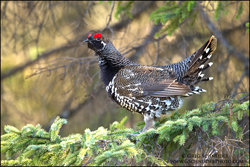State Moves to Save Spruce Grouse
 |
The New York State Department of Environmental Conservation (DEC) adopted a new Spruce Grouse Recovery Plan to enhance and restore spruce grouse populations in New York State, DEC Commissioner Joe Martens announced last week.
“Recommendations in the plan are intended to stabilize and improve the distribution and abundance of this rare bird species and ultimately increase its population,” Commissioner Martens said. “The spruce grouse is an historic resident of New York State and represents an important and visible component of the forest community.”
Spruce grouse (or Canada Grouse) were first listed as a threatened species in New York in1983 and later moved to the endangered species list in 1999, as a result of continued declines in the population. Conservation of spruce grouse and their habitat is important to preserving New York’s biodiversity and unique character. New York is at the southern end of their range.
The plan includes managing habitat, reintroducing spruce grouse into selected sites, and conducting research to determine the best source of birds for reintroduction into New York.
Preliminary genetic testing indicates that without human help, New York’s spruce grouse bird population may be lost.
“The spruce grouse is perhaps the best-known icon and a perfect representative of boreal habitats in New York,” said Michale Glennon, Adirondack Landscape Science coordinator of the Wildlife Conservation Society. “These northern peatlands are used by numerous species and are extremely important to New York’s biodiversity.... These birds and their habitat represent a small piece of the true boreal forest and draw untold numbers of birders who seek them out.”
Herbert Boyce, from Northwoods Forest Consultants, LLC, said: “...For the spruce grouse, a species evidently in need of habitat management, no accepted management methods have yet been developed that can be applied broadly. This plan discusses methods for testing management strategies in an experimental framework to determine which strategies will be most effective in maintaining persistent grouse populations in New York. Reversing human-caused habitat changes that occurred in the 1800s and early 1900s can only be done with carefully planned and executed forest management to produce desired habitat and associated species for the long term.”
Under Environmental Conservation Law, a recovery plan can be prepared to provide guidance for improving the status of the species, eventual recovery of populations and removal from New York’s Endangered Species List. DEC biologists will develop specific steps to implement the spruce grouse recovery plan, beginning with an evaluation of the feasibility of moving a small number of healthy spruce grouse from Canada to an experimental site in northern New York.
The Spruce Grouse Recovery Plan is available on DEC’s website at http://www.dec.ny.gov/animals/89794.html.
The Spruce Grouse lives in coniferous boreal forests in North America. It is one of the most arboreal grouse, well adapted to perching and moving about in trees. When approached by a predator, it relies on camouflage and immobility, letting people come within a few feet before taking flight, a behavior that has earned it the moniker "fool hen.”
Spruce Grouse are 15–17 inches long; males weigh 19–23 oz and females 16–19 oz.
Spruce Grouse live in conifer-dominated forests, be it pine, spruce, or fir. They prefer young stands. In summer they can be found near rich understory of blueberries and other shrub. In winter they prefer denser stands. The staple food is conifer needles, clipped directly from the tree.
Males are promiscuous; they disperse and advertise a territory that is visited by females for mating. Females are solely responsible for the rest of the reproductive effort. Up to 10 eggs may be laid, the usual number being 4-7.
At 70–100 days of age, chicks leave the group and become independent. Females breed once a year.
Their lifespan is about 5–6 years.
This species prefers to walk on the ground or along tree limbs rather than fly. Flights are usually over short distances, most commonly from the ground to a tree nearby, or vice-versa.
Adults fall prey to hawks, owls, foxes and coyotes.
Spruce Grouse eggs are taken by red squirrels, foxes and weasels.
In the United States this bird is a protected species. It boasts healthy populations in Canada.